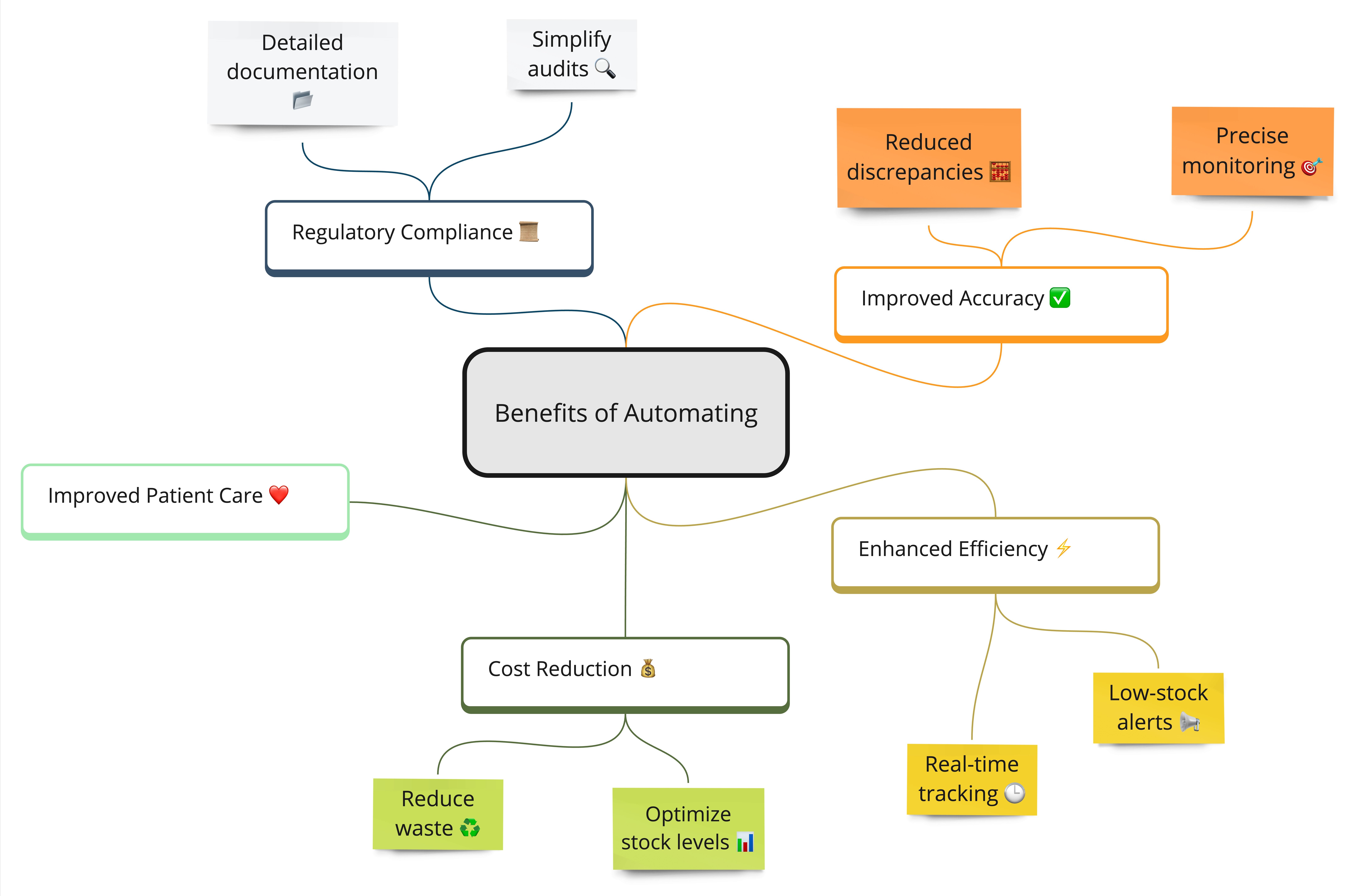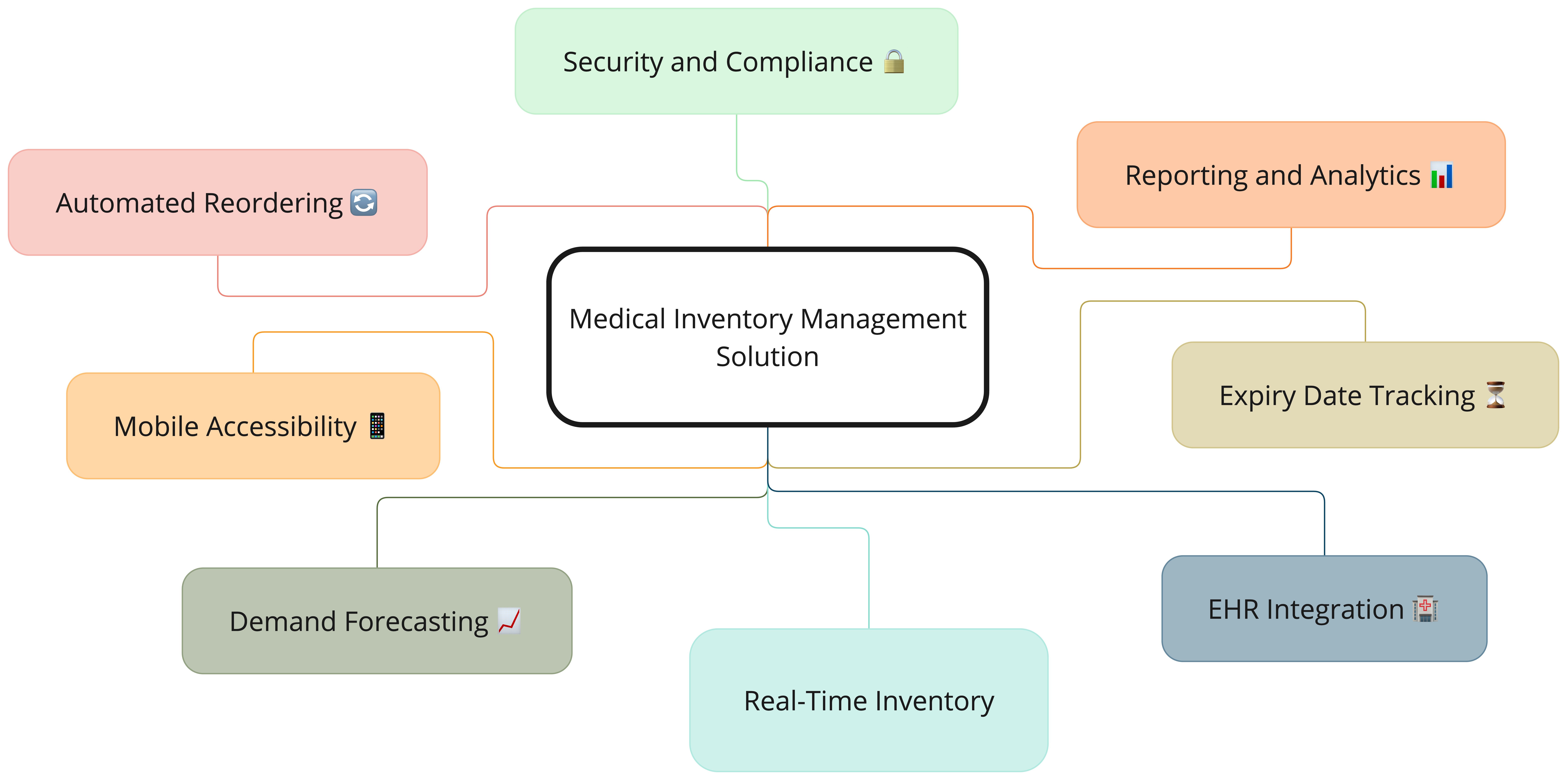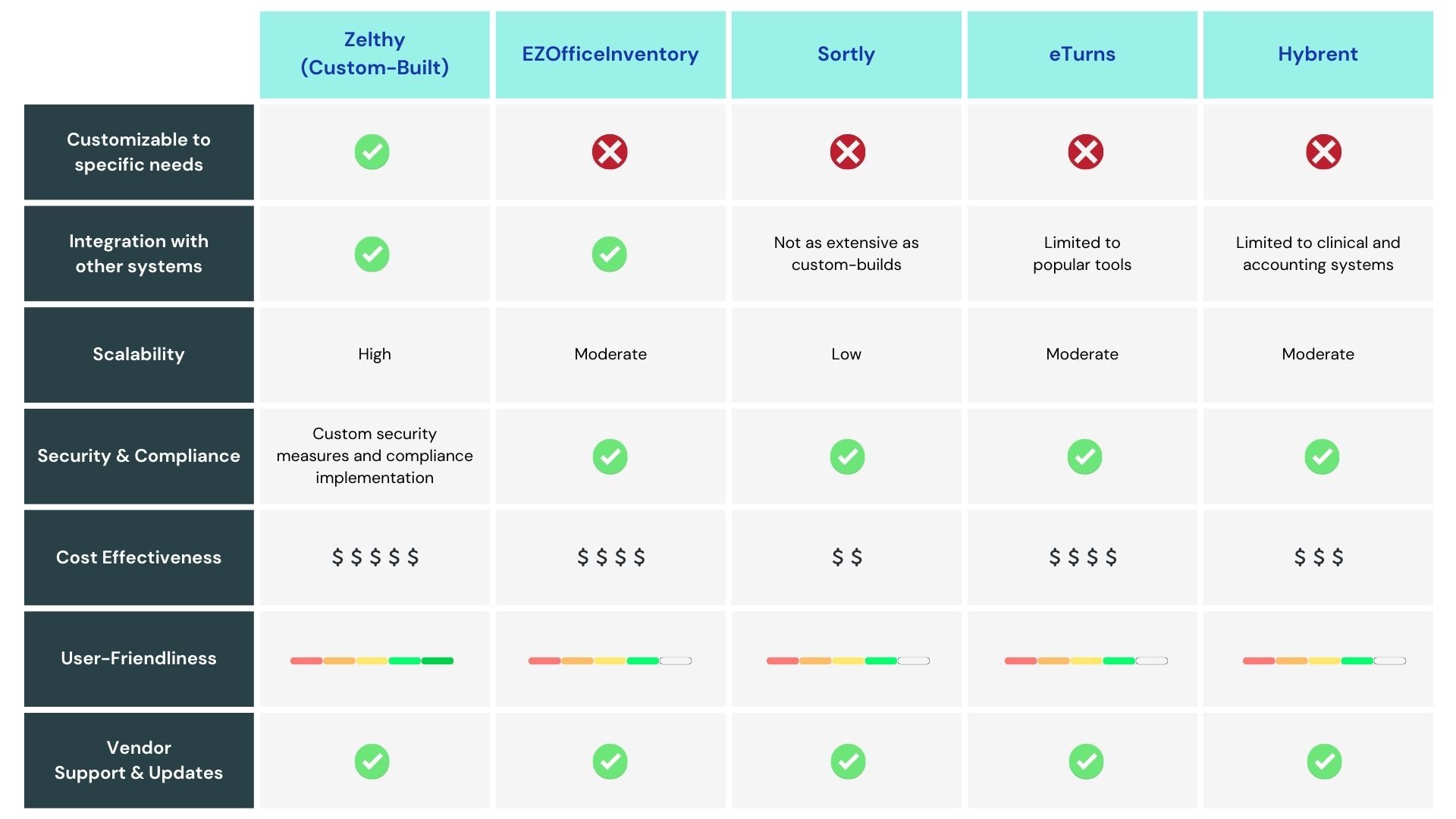Medical Inventory Management: Optimize Hospital Supplies and Reduce Costs
Jan 6, 2025
Share the article
Introduction
Managing medical inventory is more than just keeping track of supplies; it’s a matter of life and death. Effective healthcare inventory management ensures that hospitals and clinics always have the right tools, medications, and medical devices when needed. A well-structured medical stock management system can prevent shortages, minimize waste, and optimize hospital operations.
Key Takeaways
Why It Matters: Effective medical inventory management is critical for ensuring patient care, reducing waste, and maintaining seamless operations in healthcare organizations.
Core Challenges: Stockouts, overstocking, manual errors, and compliance issues.
Automation Benefits: Real-time tracking, cost savings, and regulatory ease.
What to Look For in a System: Choose medical inventory systems with real-time tracking, automated reordering, expiry date alerts, and robust reporting features to maximize efficiency and ensure patient safety.
What is Medical Inventory Management?
Medical inventory management systems provide a systematic approach to tracking, organizing, and maintaining a hospital’s supplies, equipment, and consumables. A well-implemented medicine inventory management system ensures that hospitals efficiently manage their medical supply inventory, reducing waste and improving operational efficiency. It ensures that essential items—like pharmaceuticals, surgical tools, medical devices, and disposable products—are available when needed, without excess or shortage.
Why is it Important?
Efficient healthcare inventory management plays a critical role in patient care and operational efficiency. It minimizes waste, reduces costs, and ensures compliance with healthcare regulations. For hospitals and clinics, it translates to seamless operations, timely treatments, and improved patient outcomes.
Key Aspects of Medical Inventory Management
Medical inventory management involves various components crucial to hospital operations:
Pharmaceuticals: Managing stock levels and expiry dates to avoid shortages and overstocking is a key feature of any hospital inventory management system.
Surgical Instruments: Ensures proper sterilization, availability, and readiness of these tools for emergency and scheduled procedures.
Medical Devices: Ensuring devices like ventilators or monitors are functional and available is a core function of medical inventory management software.
Consumables: Gloves, syringes, and gauze must be stocked in appropriate quantities to meet daily demand.
Effective inventory management relies on technology, such as automated medical inventory tracking systems, to streamline processes and enhance accuracy.
Benefits of Automating Hospital Inventory Management
An automated medical inventory management system eliminates manual tracking errors and ensures that hospitals have a real-time overview of available stock. With an efficient medical inventory management software, healthcare providers can streamline their workflows, reduce unnecessary costs, and ensure better patient care.
Enhanced Efficiency: Automated systems can track stock levels in real time, eliminating time-consuming manual checks. Alerts for low-stock items or expired products ensure timely reordering, preventing shortages.
Improved Accuracy: With automated medical inventory tracking, discrepancies in inventory are significantly reduced. Barcoding and RFID technology enable precise monitoring of medical supplies and equipment, ensuring the right items are available when needed.
Cost Reduction: Overstocking and wastage are common issues in manual systems. Automation optimizes medical supply inventory management, reducing unnecessary expenditures and freeing up resources for other critical areas.
Improved Patient Care: Timely access to medical supplies directly impacts patient outcomes. For instance, ensuring the availability of life-saving drugs or functioning medical devices can make a significant difference during emergencies.
Regulatory Compliance: Healthcare regulations often require strict documentation and traceability of medical supplies. Automated systems provide detailed records that simplify compliance and audits.

Challenges of Hospital Inventory Management
Hospitals that rely on manual hospital inventory tracking often face inaccurate data, delayed reordering, and difficulty maintaining compliance. Implementing a hospital inventory management system helps prevent these inefficiencies by providing real-time visibility into stock levels and usage. Here are the key challenges healthcare providers face:
Stockouts and Overstocking: Hospitals often struggle to balance inventory levels. Stockouts can delay critical treatments, while overstocking leads to wasted resources and increased storage costs.
Expiry Management: Tracking expiration dates for medical supplies and drugs is a major hurdle. Expired items not only waste money but also pose patient safety risks if accidentally used.
Inventory Shrinkage: Theft, misplacement, or unrecorded usage of supplies leads to inventory shrinkage. Without robust tracking, identifying and addressing these issues is challenging.
Manual Processes and Inaccurate Data: Manual inventory management is prone to human error, leading to inaccurate records. These errors can cascade, affecting ordering, billing, and availability of supplies.
Compliance Issues: Hospitals must adhere to strict regulations regarding inventory traceability and reporting. Non-compliance can result in fines, legal risks, and reputational damage.
Operational Inefficiencies: Without streamlined processes, staff may spend excessive time locating or ordering supplies, detracting from patient care.
By addressing these challenges through modern medical inventory systems, hospitals can enhance efficiency, ensure compliance, and provide better care.
Key Features to Look for in a Medical Inventory Management System
Choosing the right medical inventory management system is crucial for operational efficiency and patient care. Here are the key features to consider:
Real-Time Inventory Tracking: Enables accurate stock monitoring and minimizes discrepancies.
Demand Forecasting: Predicts inventory needs based on historical data.
Automated Reordering: Alerts or reorders when stock reaches preset thresholds.
Expiry Date Tracking: Ensures expired items are removed promptly.
Reporting and Analytics: Provides insights into usage trends and cost-saving opportunities.
EHR Integration: Synchronizes inventory with patient records for better coordination.
Mobile Accessibility: Allows on-the-go inventory management.
Security and Compliance: Ensures data protection and adherence to healthcare regulations.

These features help optimize resources, reduce costs, and improve overall healthcare operations.
Off-The-Shelf vs Custom Builds
When selecting a medical inventory management system, healthcare organizations often face the decision between off-the-shelf solutions and custom-built systems. Each approach has distinct advantages and considerations, particularly concerning cost.
Off-the-Shelf Medical Inventory Management Systems
Off-the-shelf solutions are pre-built software packages designed for general use across various industries. They offer standardized features that can be quickly implemented with minimal customization.
Advantages:
Lower Initial Cost: These systems typically have a lower upfront investment, making them accessible for organizations with limited budgets.
Quick Deployment: With predefined features, implementation is faster, allowing organizations to start using the system promptly.
Vendor Support: Established vendors provide ongoing support and regular updates, ensuring the system remains functional and secure.
Considerations:
Limited Customization: Off-the-shelf systems may not fully align with specific organizational workflows, potentially requiring workarounds.
Scalability Issues: As organizations grow, these systems might not scale effectively, necessitating future system changes.
Security Concerns: Standard security features may not meet specific regulatory requirements, posing potential risks.
Custom-Built Medical Inventory Management Systems
Custom-built systems are developed specifically to meet the unique needs of an organization, offering tailored solutions that align closely with existing workflows.
Advantages:
Tailored Fit: Custom systems are designed to address specific workflows and challenges, providing a precise fit for the organization.
Scalability: These systems can be designed to grow with the organization, accommodating future expansion and evolving needs.
Enhanced Security: Custom solutions can be developed to meet specific security and compliance standards, ensuring data protection.
Considerations:
Higher Initial Cost: The development of custom systems requires a significant upfront investment, which can be a barrier for some organizations.
Longer Implementation Time: Developing and deploying a custom system takes more time compared to off-the-shelf solutions.
Ongoing Maintenance: Custom systems require continuous maintenance and updates, which can incur additional costs.
Cost Comparison
While off-the-shelf solutions offer lower initial costs, custom-built systems typically have higher upfront costs due to development and implementation. However, Zelthy stands out by offering custom-built solutions at a significantly lower cost than traditional methods. Zelthy’s platform is built to reduce development time and costs through its pre-built templates, AI-powered coding assistance, and open-source nature. This makes it possible for organizations to create highly tailored solutions at 50%-70% lower development costs compared to traditional custom development approaches.
This cost advantage arises because Zelthy eliminates the need for extensive manual coding and customization that would typically drive up the price in a traditional development model. Even though Zelthy is a custom-built solution, it offers the flexibility and precision of a tailored system, combined with the affordability of a pre-configured platform that accelerates deployment and minimizes costs.
In contrast, off-the-shelf solutions may be less costly initially but can result in higher long-term expenses due to workarounds, scalability limitations, and lack of alignment with the organization’s unique needs. Custom-built systems, like those on Zelthy, offer greater value over time due to their adaptability and lower ongoing development costs.
In summary, the choice between off-the-shelf and custom-built medical inventory management systems depends on an organization's specific needs, budget constraints, and long-term strategic goals. Off-the-shelf solutions may be suitable for organizations seeking quick deployment and lower initial costs, while custom-built systems are ideal for those requiring tailored solutions and willing to invest in long-term benefits.
Top 5 Ways To Build a Medical Inventory Management System
When developing a medical inventory management system, it's essential to consider various approaches to ensure efficiency, accuracy, and scalability. Below are the top five methods, starting with a custom-built solution, followed by leading off-the-shelf tools:
1. Custom-Built Solution (e.g., Zelthy)
Developing a custom-built medical inventory management system, such as one built on the Zelthy platform, offers unparalleled flexibility and alignment with specific organizational needs. Zelthy provides an open platform for building, deploying, and scaling healthcare applications with AI-driven code assistance. This approach allows for complete control over features, integrations, and compliance requirements, ensuring the system evolves with the organization's growth and regulatory changes.
2. EZOfficeInventory
EZOfficeInventory is a web-based asset tracking software that offers comprehensive features for medical inventory management. It provides barcode and QR code scanning for easy asset tracking, maintenance tracking to ensure equipment is operational and compliant, and inventory control with low stock alerts and automatic reordering. Additionally, it offers detailed reporting and analytics for insights into inventory usage and integration capabilities with other healthcare management systems.
3. Sortly
Sortly is an intuitive, visual inventory tracking system designed to simplify the management of medical supplies and equipment. It features easy-to-use visual inventory tracking with images and QR/barcode scanning, customizable tags and categories for streamlined organization, and low stock alerts with automatic reorder reminders to prevent shortages. Sortly is accessible via a mobile app for on-the-go management and updates, making it suitable for healthcare providers seeking a user-friendly interface.
4. eTurns
eTurns is an automated inventory management and replenishment app crafted with a mobile-first approach, compatible with iOS/Android devices, scanners, sensors, and RFID machines. It assists in tracking usage, automating replenishment, and offers customizable reports and analytics. eTurns is tailored specifically for businesses aiming to optimize and streamline the replenishment process, including healthcare professionals.
5. Hybrent
Hybrent is a procurement platform tailored for healthcare facilities, offering multi-vendor purchasing, digital invoicing, and spend management. It integrates with various accounting and clinical applications, streamlining procurement workflows and enhancing staff efficiency. Hybrent's easy-to-use software optimizes procurement workflows, digital invoicing, and spend management, all while boosting staff efficiency.

Each of these solutions offers distinct advantages, and the choice depends on the specific needs, resources, and strategic goals of the healthcare organization.
Future Trends in Healthcare Inventory Management
Medical inventory management is evolving rapidly, thanks to emerging technologies:
Artificial Intelligence (AI): AI-powered systems improve demand forecasting and automate inventory decisions, reducing waste.
Internet of Things (IoT): Smart sensors track inventory in real time, offering precise data on usage and location.
Predictive Analytics: These tools analyze past trends to predict future inventory needs and optimize stock levels.
Blockchain: Enhances supply chain transparency, ensuring secure and traceable inventory records.
Robotics: Automates storage and retrieval processes, improving efficiency and reducing manual effort.
These advancements promise greater accuracy, cost savings, and improved healthcare outcomes.
How Zelthy Leverages Technology for Smarter Healthcare Inventory Management
Built on the flexible and scalable Zelthy platform, Zelthy’s Medical Inventory Management offers an integrated, data-driven approach to streamline inventory management, reduce costs, and enhance operational efficiency.
Key Features of Zelthy’s Solution
Real-Time Inventory Tracking: Zelthy provides real-time visibility into inventory levels with barcode scanning and RFID integration, ensuring that critical supplies are always available across multiple locations.
Automated Reordering and Expiry Management: Zelthy’s intelligent algorithms automatically trigger reorder alerts when stock falls below predefined levels, preventing stockouts. The system also tracks expiry dates, ensuring expired items are removed and improving patient safety.
Data-Driven Insights for Cost Savings: Zelthy generates actionable insights through advanced reporting and analytics, enabling healthcare providers to optimize inventory allocation and reduce waste, leading to significant cost savings.
Seamless EHR Integration: Zelthy integrates smoothly with Electronic Health Records (EHR), aligning inventory management with patient care needs. This integration ensures timely availability of supplies, enhancing efficiency and reducing delays.
Scalability Across Healthcare Networks: Zelthy’s cloud-based platform scales effortlessly, allowing healthcare organizations to manage inventory across multiple locations in real time, ensuring consistency and continuity in inventory management.
Future-Ready Operations
Zelthy’s integration of advanced technologies like AI, IoT, and predictive analytics keeps healthcare operations ahead of the curve. By adopting Zelthy’s Medical Inventory Management Solution, healthcare providers can move from a reactive to a proactive, data-driven inventory strategy. This not only enhances operational efficiency but also improves patient outcomes, making Zelthy an invaluable tool for modern healthcare systems.
Conclusion
Implementing a reliable medical supply inventory management system is essential for any healthcare provider looking to reduce costs, streamline operations, and enhance patient care. Whether you need an inventory management hospital solution or a custom medical inventory system, Zelthy’s powerful platform offers hospital inventory tracking and automated workflows to ensure you never run out of critical supplies.
Ready to optimize your hospital's inventory management? Book a free consultation with our experts today and discover how Zelthy can help you build a tailored, efficient, and compliant inventory system.
Book a Call Today and take control of your medical inventory management!
Frequently Asked Questions About Medical Inventory Management
1. What is medical inventory management?
Medical inventory management involves overseeing and controlling the availability, storage, tracking, and utilization of medical supplies and equipment within healthcare facilities.
2. How do hospitals keep track of inventory?
Hospitals utilize automated inventory management systems that employ technologies like barcodes, RFID tags, and real-time tracking software to monitor stock levels, usage, and expiration dates, ensuring efficient supply chain operations.
3. Why is inventory so important in a healthcare facility?
Effective inventory management ensures the availability of necessary medical supplies, reduces waste, prevents stockouts, and maintains patient safety, all while controlling costs.
4. What are the different types of inventory in a medical setup?
Medical inventory includes consumables (e.g., bandages, syringes), pharmaceuticals, medical devices (e.g., surgical instruments), and capital equipment (e.g., MRI machines).
5. What is the best practice for healthcare inventory management?
Best practices involve streamlining inventory processes, optimizing stock levels, centralizing and categorizing storage, automating management systems, training staff, conducting regular audits, and utilizing technologies like RFID for real-time tracking.
6. What is the inventory management process in healthcare?
The process includes assessing current inventory, categorizing items, setting par levels, automating ordering and restocking, tracking usage, conducting regular audits, and analyzing data to optimize supply levels.
7. What is used to track inventory of clinical supplies?
Clinical supplies are tracked using barcode scanning, RFID tags, and real-time location systems (RTLS) integrated with inventory management software for accurate monitoring.
8. What is the most commonly used inventory system?
The most commonly used inventory systems in healthcare are automated inventory management systems that integrate technologies like barcodes and RFID for real-time tracking and data analysis.
9. What is the main purpose of inventory management?
The main purpose is to ensure the availability of necessary supplies, prevent shortages and overstocking, maintain patient safety, and control costs within healthcare facilities.
10. What is the key driver to effective inventory management?
Key drivers include accurate data collection, real-time tracking technologies, staff training, standardized processes, and regular audits to maintain optimal inventory levels.
11. How to manage inventory in Excel?
Inventory can be managed in Excel by creating spreadsheets to track item names, quantities, reorder levels, and expiration dates, and by using formulas to monitor stock levels and generate alerts for restocking.
12. What is the most commonly used inventory method in pharmacy?
The most commonly used inventory method in pharmacies is the perpetual inventory system, which continuously updates stock levels in real-time as transactions occur.
13. What is inventory management in the pharmaceutical industry?
Inventory management in the pharmaceutical industry involves overseeing the procurement, storage, distribution, and tracking of medications to ensure availability, compliance with regulations, and prevention of stockouts or expirations.
14. What is healthcare inventory management?
Healthcare inventory management is the systematic process of overseeing and controlling the availability, storage, tracking, and utilization of medical supplies and equipment within healthcare facilities.
15. What is the simplest way to manage inventory?
The simplest way to manage inventory is by implementing a basic tracking system, such as a spreadsheet, to monitor stock levels, usage, and reorder points, though this may lack the efficiency and accuracy of automated systems.
Write to us at connect@zelthy.com to learn more about our solutions and how they can enhance your healthcare efficiency. Or DM us on LinkedIn.



